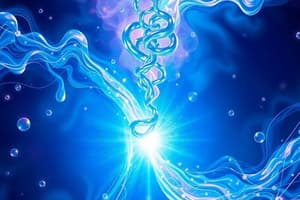Podcast
Questions and Answers
The reaction $CaCO_3 \rightleftharpoons CaO + CO_2 (g)$ goes to completion in lime kiln because
The reaction $CaCO_3 \rightleftharpoons CaO + CO_2 (g)$ goes to completion in lime kiln because
- $CO_2$ escapes continuously
- $CaO$ is more stable than $CaCO_3$
- $CaO$ is not dissociated
- Of the high temperature (correct)
All reactions which have chemical disintegration
All reactions which have chemical disintegration
- Is reversible (correct)
- Is exothermic
- Is reversible or irreversible and exothermic or exothermic
- Is exothermic and endothermic
Which of the following is reversible process
Which of the following is reversible process
- Mixing of two gases by diffusion (correct)
- Melting of ice at 10°C
- Evaporation of water at 100°C and 1 atm pressure
- None of the above
In the given reaction $N_2 + O_2 \rightleftharpoons 2NO$, equilibrium means that
In the given reaction $N_2 + O_2 \rightleftharpoons 2NO$, equilibrium means that
Which of the following is irreversible reaction
Which of the following is irreversible reaction
The number of gram molecules of a substance present in unit volume is termed as
The number of gram molecules of a substance present in unit volume is termed as
The free energy for a reversible reaction at equilibrium is
The free energy for a reversible reaction at equilibrium is
Which of the following statements regarding a chemical equilibrium is wrong
Which of the following statements regarding a chemical equilibrium is wrong
For the synthesis of ammonia by the reaction, $N_2 + 3H_2 \rightleftharpoons 2NH_3$, in the Haber Process, the attainment of equilibrium is correctly predicted by the curve
For the synthesis of ammonia by the reaction, $N_2 + 3H_2 \rightleftharpoons 2NH_3$, in the Haber Process, the attainment of equilibrium is correctly predicted by the curve
Which of the following conditions represents an equilibrium state
Which of the following conditions represents an equilibrium state
In any chemical reaction, equilibrium state is supposed to be established when
In any chemical reaction, equilibrium state is supposed to be established when
In chemical reaction $A \rightleftharpoons B$, the system will be known in equilibrium when
In chemical reaction $A \rightleftharpoons B$, the system will be known in equilibrium when
On cooling a freezing mixture, colour of the reaction turns to pink from deep blue for a mixture $CoCl_2^4 + 4Cl^- \rightleftharpoons Co(H_2O)_6^{2+} + 4Cl^-$
On cooling a freezing mixture, colour of the reaction turns to pink from deep blue for a mixture $CoCl_2^4 + 4Cl^- \rightleftharpoons Co(H_2O)_6^{2+} + 4Cl^-$
Theory of 'active mass' indicates that the reaction is directly proportional to the
Theory of 'active mass' indicates that the reaction is directly proportional to the
Flashcards
Reversible Reaction
Reversible Reaction
A reaction that can proceed in both forward and reverse directions, where products can react to form reactants again.
Irreversible Reaction
Irreversible Reaction
A reaction that can proceed in only one direction, where reactants are completely converted to products.
Chemical Equilibrium
Chemical Equilibrium
The point in a reversible reaction where the rates of the forward and reverse reactions are equal, resulting in no net change in the concentrations of reactants and products.
Dynamic Equilibrium
Dynamic Equilibrium
Signup and view all the flashcards
Exothermic Reaction
Exothermic Reaction
Signup and view all the flashcards
Endothermic Reaction
Endothermic Reaction
Signup and view all the flashcards
Molar Concentration
Molar Concentration
Signup and view all the flashcards
Equilibrium State
Equilibrium State
Signup and view all the flashcards
Equilibrium Constant (K)
Equilibrium Constant (K)
Signup and view all the flashcards
Catalyst
Catalyst
Signup and view all the flashcards
Rate of Reaction
Rate of Reaction
Signup and view all the flashcards
Le Chatelier's Principle
Le Chatelier's Principle
Signup and view all the flashcards
Product-Favored Reaction
Product-Favored Reaction
Signup and view all the flashcards
Reactant-Favored Reaction
Reactant-Favored Reaction
Signup and view all the flashcards
Increasing Temperature
Increasing Temperature
Signup and view all the flashcards
Decreasing Temperature
Decreasing Temperature
Signup and view all the flashcards
Increasing Pressure
Increasing Pressure
Signup and view all the flashcards
Decreasing Pressure
Decreasing Pressure
Signup and view all the flashcards
Adding Reactants
Adding Reactants
Signup and view all the flashcards
Adding Products
Adding Products
Signup and view all the flashcards
Essentially Irreversible Reaction
Essentially Irreversible Reaction
Signup and view all the flashcards
Equilibrium Yield
Equilibrium Yield
Signup and view all the flashcards
Shifting Equilibrium
Shifting Equilibrium
Signup and view all the flashcards
Reversible Reaction
Reversible Reaction
Signup and view all the flashcards
Reverse Reaction
Reverse Reaction
Signup and view all the flashcards
Reaction Kinetics
Reaction Kinetics
Signup and view all the flashcards
Study Notes
Chemical Equilibrium
- Equilibrium: A state in a reversible reaction where the rate of the forward reaction equals the rate of the reverse reaction. The concentrations of reactants and products remain constant.
- Reversible Reactions: Reactions that can proceed in both forward and reverse directions.
- Irreversible Reactions: Reactions that proceed essentially to completion in one direction. Calcium carbonate decomposing into calcium oxide and carbon dioxide is an example of a reaction that proceeds to completion. This is due to factors like high temperature, the greater stability of products, or the continuous removal of a product gas—as occurs in lime kilns.
- Chemical Equilibrium State: The system is in equilibrium when the rates of the forward and reverse reactions are equal. This leads to constant concentrations of reactants and products.
- Dynamic Equilibrium: Equilibrium is dynamic. The forward and reverse reactions continue to occur, but at equal rates.
- Equilibrium Constant (K): In a reaction at equilibrium, the ratio of product concentrations to reactant concentrations raised to their stoichiometric coefficients is constant.
- Active Mass: The number of gram molecules of a substance per unit volume can also be termed as its activity.
- Standard Free Energy Change (∆G): At equilibrium, the standard free energy change of a reversible reaction is zero.
- Equilibrium Shifting: Changing conditions such as temperature, pressure, or concentration can shift the equilibrium.
- Catalyst: Catalysts do not affect the position of equilibrium; they only speed up the reaction rate.
- Le Chatelier's Principle: This principle describes how a change in conditions affects a system at equilibrium.
- Conditions for Equilibrium: Mutual opposite reactions with identical velocities leads to system at an equilibrium state.
- Identifying an Equilibrium State: Fifty percent change of substances in both directions and constant velocity of changes to substances are indicator of equilibrium.
- Equilibrium Graph: A graph can be used to demonstrate equilibrium by showing how concentrations of products and reactants change with time until both rates are equal.
- Theory of Active Mass: Equilibrium is directly proportional to the concentration of reactants.
Studying That Suits You
Use AI to generate personalized quizzes and flashcards to suit your learning preferences.




